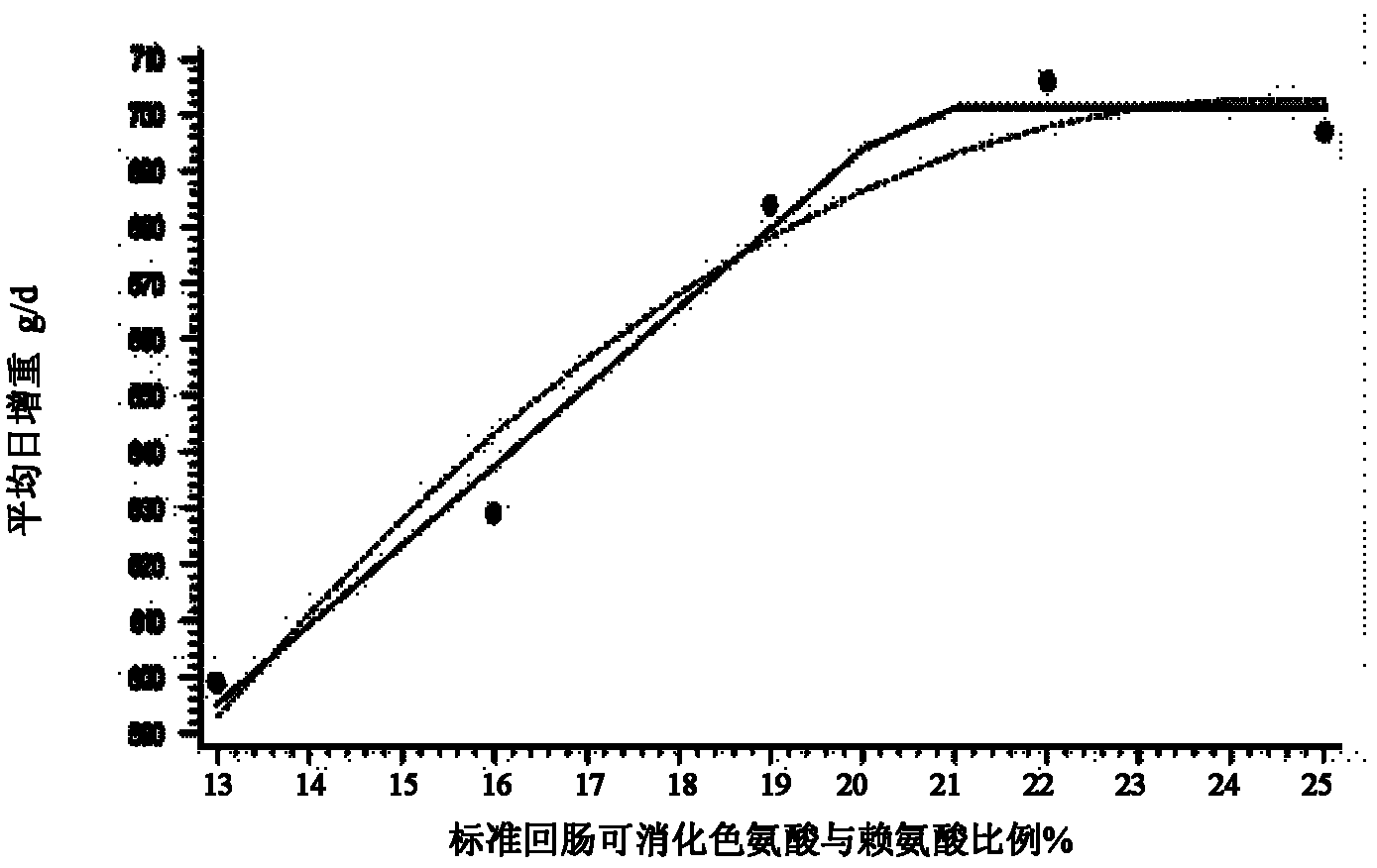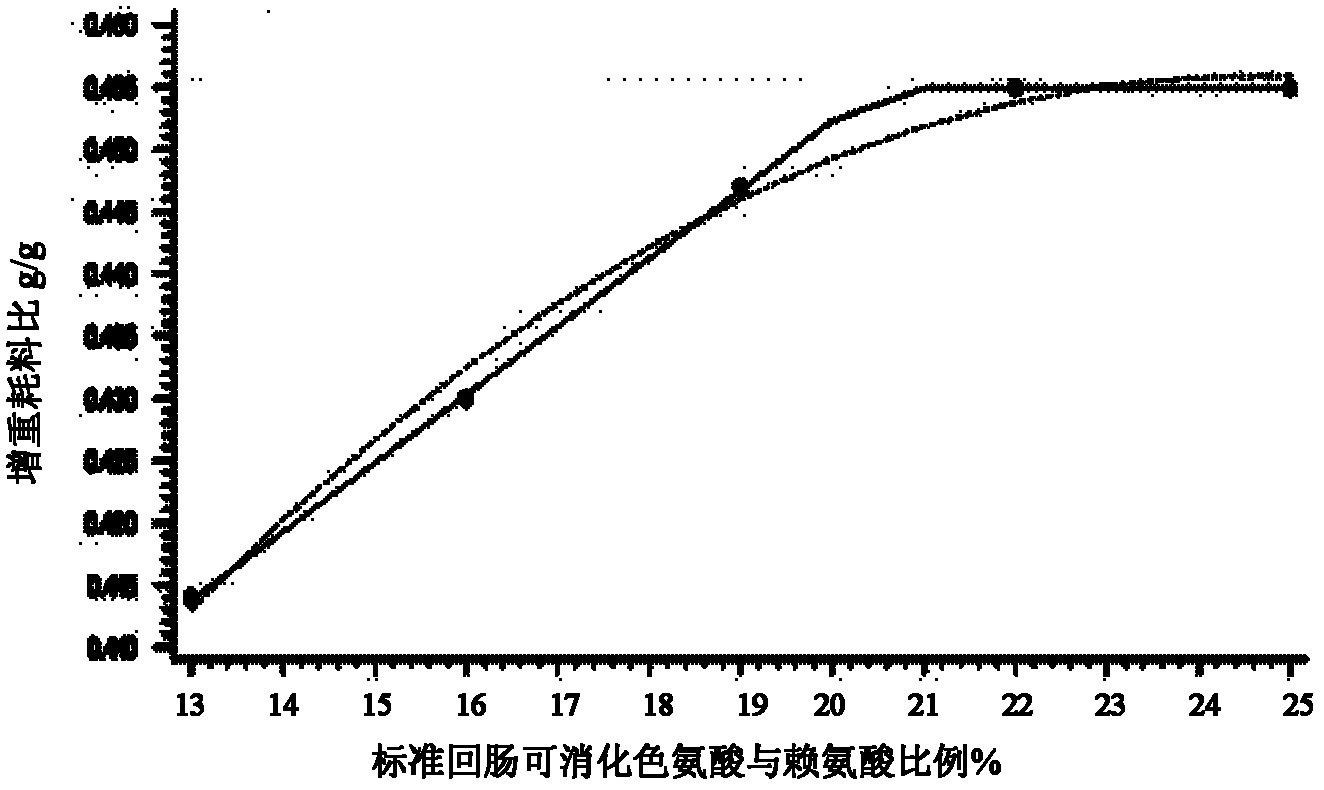Low-nitrogen-emission daily ration for growing pigs
A technology for nitrogen discharge and growing pigs, applied in animal feed, additional food elements, animal feed, etc., can solve the problems of less research on amino acid requirements, improve intestinal health, increase absorption rate, and reduce nitrogen discharge Effect
- Summary
- Abstract
- Description
- Claims
- Application Information
AI Technical Summary
Problems solved by technology
Method used
Image
Examples
Embodiment 1
[0021] Example 1. Verifying the optimal ratio of tryptophan to lysine in the standard ileum of growing pigs under the condition of low nitrogen emission diet
[0022] 1.1 Experimental animals and experimental diets
[0023] The experiment adopted a completely randomized design. In experiment 1, 180 Duroc × Landrace × Large White Sanyuan healthy growing pigs with an average initial body weight of 25.08±2.72kg were selected. According to the principle of similar body weight and similar genetic basis, they were randomly divided into 3 treatments, and each treatment had 6 replicates ( pen), 10 pigs per pen, half male and half female, and the test period was 35 days. In the second experiment, 300 Duroc × Changbai × Large White Sanyuan healthy growing pigs with an average initial body weight of 24.74±2.38kg were selected, divided into 5 treatments, each treatment had 6 repetitions (columns), and 10 pigs per pen were tested. The period is 35 days.
[0024] The dietary crude protei...
Embodiment 2
[0072] Example 2. Verifying the optimal ratio of threonine and lysine in the standard ileum of growing pigs under the condition of low nitrogen emission diet
[0073] 1.1 Experimental animals and experimental diets
[0074] In experiment 1, 144 Duroc × Landrace × Large White Sanyuan healthy growing pigs with an average initial body weight of 22.14±1.89kg were selected. According to the principle of similar weight and genetic basis, they were randomly divided into 3 treatments, and each treatment had 6 repetitions. There were 8 pigs in each repetition (column), and the test period was 35 days. In Experiment 2, 300 Duroc × Landrace × Large White three-way hybrid growing pigs with an average initial body weight of 22.65±2.64kg were selected. According to the principle of similar weight and genetic basis, they were randomly divided into 5 treatments, and each treatment had 6 repetitions. Each repetition (column) has 10 pigs, half male and half female, and the test period is 39 da...
Embodiment 3
[0115] Example 3. Verifying the optimum ratio of sulfur-containing amino acids and lysine in the standard ileum of growing pigs under the condition of low nitrogen emission diet
[0116] 1.1 Materials and methods
[0117] 1.1.1 Test animals and test diets
[0118] The experiment adopts single factor experiment design. A total of 360 healthy fattening pigs of Duroc × Landrace × Large White Sanyuan with an average initial body weight of 25.67±2.74kg were selected. According to the principle of similar weight and genetic basis, they were randomly divided into 5 treatments, and each treatment had 6 replicates. Repeat (column) 12 pigs, half male and half female, and the test period is 25-50kg stage.
[0119] The experimental diets were all low-nitrogen emission diets, and the protein level was lowered by 4 percentage points based on the crude protein level of growing pig diets recommended by the "Pig Feeding Standards" (2004), and the net energy level of the diets was uniformly s...
PUM
 Login to View More
Login to View More Abstract
Description
Claims
Application Information
 Login to View More
Login to View More - R&D
- Intellectual Property
- Life Sciences
- Materials
- Tech Scout
- Unparalleled Data Quality
- Higher Quality Content
- 60% Fewer Hallucinations
Browse by: Latest US Patents, China's latest patents, Technical Efficacy Thesaurus, Application Domain, Technology Topic, Popular Technical Reports.
© 2025 PatSnap. All rights reserved.Legal|Privacy policy|Modern Slavery Act Transparency Statement|Sitemap|About US| Contact US: help@patsnap.com



